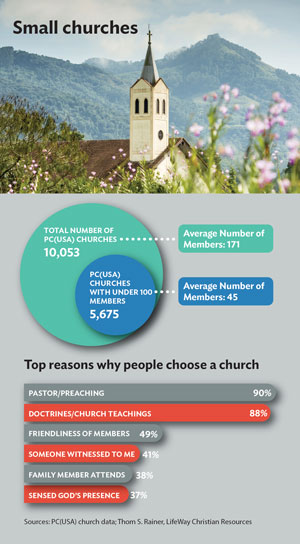Go Figure
Big benefits in small churches
by Susan Barnett
John Mellencamp’s song “Small Town” describes the benefits of growing up in a place where he knew everyone, was loved, and learned about Jesus. While his song is not about small churches, there are similarities. Small churches celebrate every birth in a big way; everyone is known and loved and learns about Jesus.
Small towns and small churches have another similarity: there are more of them than large cities and large churches. Of the 10,053 PC(USA) congregations, more than 50 percent (5,675) have fewer than 100 members. Among those congregations, the average membership is 45. Fewer than 2 percent of PC(USA) churches have more than 1,000 members. This mirrors the National Congregation Study that found that 59 percent of all churches have fewer than 100 members and that only 2.5 percent have more than 1,000 members.
There are positives in being a small church. For example, because everyone in the congregation often knows everyone else, close relationships tend to develop. Members still bring food when a birth or death occurs. Every member has a greater opportunity to be heard, and the pastor has more opportunities to give members individual attention. That sense of belonging inspires action: a greater proportion of members of small churches participate in the work of the church.
While small churches may not offer all the programs that larger churches do, they share the same purpose—to share the faith, make disciples, and build interconnected communities.
Susan Barnett is a research associate with Research Services for the Presbyterian Mission Agency.



